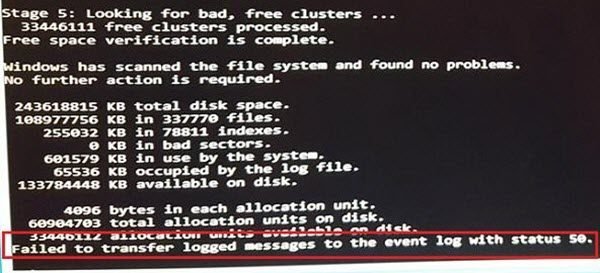One of the most common hardware problems with any computer is usually with the hard drive. If the hard drive goes wrong, you could lose a lot of important information stored in your system. Thus, Windows has provided users with the CHKDSK utility, which could help find bad sectors on the drive in advance. However, while using the CHKDSK utility, you might sometimes receive the following – Failed to transfer logged messages to the log event with status 50.
What is event log error 50?
If Windows encounters a generic error while attempting to write data onto the disk, an event ID 50 message gets logged. Such an error happens when Windows attempts to transfer data from the file system Cache Manager instead of hardware level cache to the physical disk. However, nothing is unusual here as this is a part of the Windows memory management process.

Failed to transfer logged messages to the log event with status 50
The possible causes behind this issue could be as follows:
- The hard drive or RAM is in a Read-only state.
- Problems with the physical hard drive.
- Some driver/service/malware could be preventing the system from creating logs.
If you face this issue, you can try the following methods to fix the issue:
- Verify if the hard disk is writable
- Try running CHKDSK in Safe Mode
- Check the hard disk/external drive physically.
You will need an admin account to execute these suggestions.
1] Verify if the hard disk is writable.

The CHKDSK utility checks for bad sectors in the hard drive; however, it also needs to create logs of the result. The error in the discussion is directly linked to the inability of the of the CHKDSK utility to log the logged messages. This error usually occurs when because the log cannot be written to an installation disk. The log is usually found here:
C:\Windows\System32\Logfiles\Srt\SrtTrail.txt.
Thus, verify if the drive is writable.
Log in as Administrator and right-click on the system drive and select Properties. Go to the Security tab and check if you are allowed to Modify the drive.
If not, click on Edit (as an administrator) and edit the permissions for SYSTEM and Administrators Group as shown above in the image. These are the default settings for these two groups or usernames only.
Click Apply and exit.
2] Try running CHKDSK in Safe Mode
Running the CHKDSK command after booting into the system in Safe Mode could be helpful in resolving the problem. Basically, in Safe Mode, the startup programs, add-ons, etc. settings, do not run. Once in Safe Mode use the command prompt to run the following chkdsk command:
chkdsk c: /f /r
Where ‘c’ is the Drive letter.
3] Check the hard disk/external drive physically
There’s not much we could do to fix the error if the above two solutions failed. You could tighten the wires connecting the hard disk to the motherboard. If it doesn’t help either, you might need the help of a hardware technician.
Hope something helps!
Does chkdsk fix corrupt files?
If the corrupt files are related to file system errors, CHKDSK can sometimes fix them. However, if the corruption is due to physical damage to the hard drive, CHKDSK may be unable to fix the problem. One of the ways it can fix the problem is by moving data to part of the storage, which is healthy, and once it’s done, the bad sectors are marked so data is not stored there anytime.
Leave a Reply